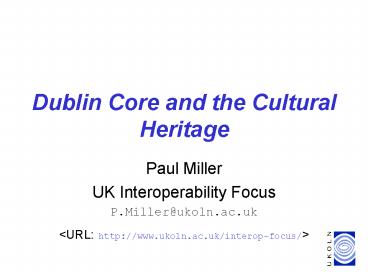Dublin Core and the Cultural Heritage - PowerPoint PPT Presentation
Title:
Dublin Core and the Cultural Heritage
Description:
Dublin Core and the Cultural Heritage. Paul ... Funded by British Library Research & Innovation Centre (BLRIC) and Joint ... Amalgamation of 3 main projects ... – PowerPoint PPT presentation
Number of Views:37
Avg rating:3.0/5.0
Title: Dublin Core and the Cultural Heritage
1
Dublin Core and the Cultural Heritage
- Paul Miller
- UK Interoperability Focus
- P.Miller_at_ukoln.ac.uk
- ltURL http//www.ukoln.ac.uk/interopfocus/gt
2
Introducing Interoperability Focus
- Funded by British Library Research Innovation
Centre (BLRIC) and Joint Information Systems
Committee (JISC) - Based at UK Office for Library Information
Networking (UKOLN) - Began work January 1999
- Funded for three years initially.
3
Introducing Interoperability Focus
- Focus upon enabling interoperability between
resources in
libraries
archives
the cultural heritage sector
etc.
4
Introducing Interoperability Focus
- By
- disseminating best practice
- participating in relevant standards development
initiatives - encouraging/ facilitating crosswalks and
crossproject communication - representing UK interests internationally
- raising awareness of interoperabilitys benefits
to users, creators holders.
5
Introducing Interoperability Focus
- Email P.Miller_at_ukoln.ac.uk
- Web http//www.ukoln.ac.uk/interopfocus/
6
CIMI
- Consortium for the Computer Interchange of Museum
Information lthttp//www.cimi.org/gt - members drawn from cultural heritage
organisations (not only museums) and system
suppliers all over the world - aims to increase use of computerbased solutions
through consensusbuilding work with member
organisations - To bring cultural heritage information to the
widest possible audience, through the use of
standards - e.g. Z39.50 Profile for the Cultural Heritage
(CIMI Profile).
7
CIMI Dublin Core Testbed
- 17 members in Phase 1 (1998)
- including
- Arts Humanities Data Service (UK)
- Blue Angel Technologies (USA)
- CHIN (Canada)
- DSTC (Australia)
- Databasix (Netherlands)
- Finsiel (Italy)
- Guggenheim (USA)
- Joanneum (Austria)
- Museum Computer Network (USA)
- National Museum of Denmark (Denmark)
- Natural History Museum (UK).
8
CIMI DCT Phase 1 Aims
- Evaluate the feasibility of using DC for the
museum community - Test implicit assumptions behind DC
- Promote international consensus on DC practices
for the museum community - Provide a forum for understanding and resolving
the various issues - Create a pool of DC records in XML for retrieval
experiments.
9
CIMI DCT Phase 1 Methods
- Four major meetings, working groups, mailing
list, web-site, activity log - Test database created by Blue Angel Technologies
- Work with the DC user guide draft
- Liaison with the main DC community, Z39.50
Testbed and others (eg ZIG).
10
CIMI DCT Phase 1 Results
- TYPE element is the key to interpretation of the
rest of record - item/collection
- original/surrogate
- event
- Close adherence to 11 model
- CREATOR and the God Problem
- RIGHTS important
- Need for Physical Description.
11
CIMI DCT Phase 1 Results
- Over 200,000 DC Simple records in the database
pool, in XML format - Analysis reveals degree of consistency /
conformance - Creation of records from scratch v. mapping onto
an existing database - Production of Cultural Heritage Annex to DC User
Guide - due for public release by Easter.
12
CIMI DCT Phase 2
- Commencing March 1999
- Add new project participants
- Extend sample record base
- introduce qualifiers and subelements
- open up for public testing and comment
- Investigate use of fully parsed RDF, rather than
CIMIdeveloped XML syntax.
13
CIMI DCT Phase 2
- Amalgamation of 3 main projects
- develop applications that can make use of the
returned data to provide a museum-like experience - map CIMI Access Points to DC
- Z39.50 Profile group
- Dublin Core Test bed
- IIM group.
- fin.































